Start with one bold statement piece as your anchor, then build around it using delicate items for balance. Create dimension by varying necklace lengths with at least 2-inch differences between layers. Mix metals like gold, silver, and rose gold while ensuring one dominates. Match your jewelry to your outfit’s neckline, distribute visual weight evenly, and incorporate contrasting textures for depth. These foundational techniques will transform your layering approach into something truly exceptional.
Start With a Foundation Piece as Your Anchor
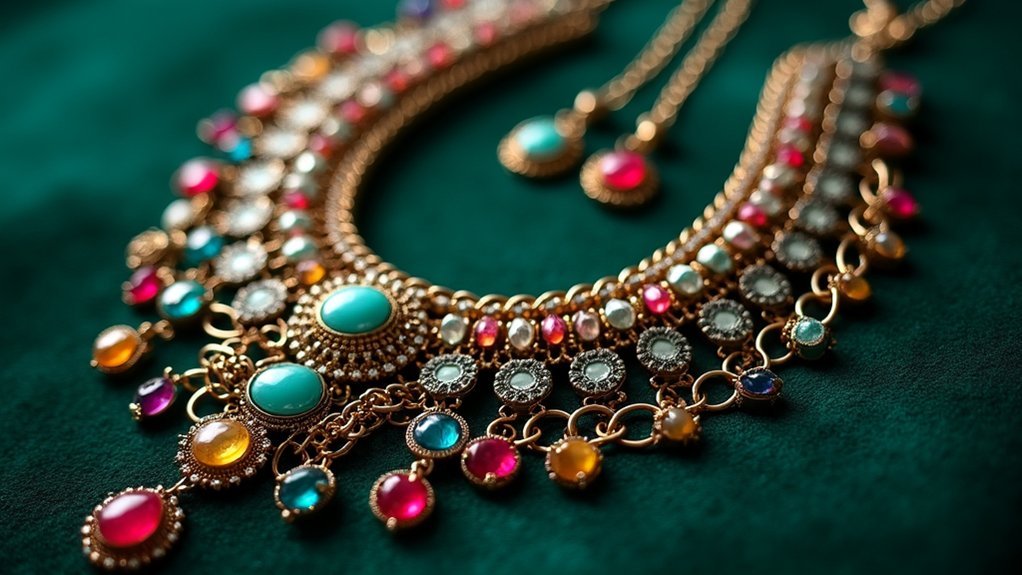
When creating a layered jewelry look, you’ll want to establish your visual hierarchy by selecting one standout piece as your anchor. This foundation piece should make a bold statement while reflecting your personal style, whether that’s modern, boho, or minimalist.
Choose something visually striking like a chunky bracelet or dramatic necklace that’ll serve as your focal point. Your anchor should feature versatile colors or designs that complement additional layers seamlessly.
Once you’ve established this foundation piece, build around it with simpler, more delicate items. This approach creates balance and prevents your layered look from becoming overwhelming.
Create Visual Balance Through Varying Lengths
After establishing your anchor piece, you’ll need to create dimension by strategically varying the lengths of your necklaces. This technique produces a cascading effect that transforms ordinary pieces into stunning layered jewelry with enhanced visual interest.
Start with shorter, dainty pieces and gradually add longer statement pieces to achieve a balanced look while preventing tangling. Aim for at least a 2-inch difference between each necklace length to maintain proper spacing and avoid visual confusion.
Layer from short to long with 2-inch spacing between each piece for optimal visual balance and tangle-free wear.
Mixing different styles proves incredibly effective—try combining delicate chokers with bold pendant necklaces. This contrast showcases each piece’s unique character while maintaining overall harmony.
The varying lengths guarantee every necklace remains distinct and visible, creating a sophisticated composition that draws the eye naturally downward through your carefully curated display.
Mix Metals and Materials for Depth and Interest
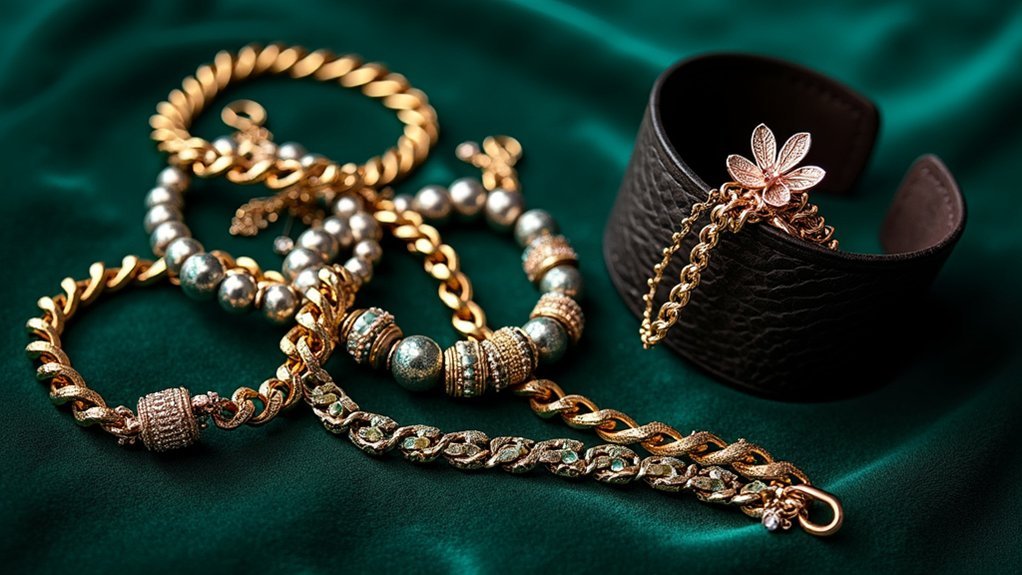
You’ll create stunning visual depth by combining gold, silver, and rose gold pieces that complement rather than compete with each other.
Mix different materials like smooth metals with textured leather or delicate beads to add tactile contrast that draws the eye across your layered design.
Balance your metal proportions by ensuring one tone dominates while others serve as accent pieces, preventing your layers from looking chaotic or overwhelming.
Gold Silver Rose Combinations
Although traditional jewelry rules once dictated sticking to a single metal, today’s fashion landscape celebrates the artful combination of gold, silver, and rose gold for sophisticated layered looks.
When you mix different metals in your statement jewelry, you’ll create visual depth that transforms ordinary pieces into extraordinary ensembles.
Start with one dominant metal as your anchor piece, then strategically incorporate the other two metals throughout your layers to achieve a harmonious look.
Distribute each metal type evenly across your necklaces, bracelets, or rings to maintain balance. You can enhance this mixed-metal approach by varying textures—pair smooth gold chains with hammered silver pendants or beaded rose gold accents.
This layering technique allows your personality to shine through while creating contemporary sophistication.
Texture Contrast Through Materials
Building on mixed-metal approaches, you can amplify your layered jewelry’s visual impact by incorporating diverse materials that create striking texture contrasts. Mixing metals with leather, beads, and chains transforms ordinary layering into statement-making artistry. When contrasting materials like sleek silver chains with chunky beaded pieces, you’ll create compelling juxtaposition that elevates your unique style.
| Material Combination | Visual Effect |
|---|---|
| Metal + Leather | Edgy sophistication |
| Chains + Beads | Textural dimension |
| Smooth + Rough | Dynamic contrast |
| Thin + Chunky | Balanced proportion |
| Matte + Shiny | Light reflection variety |
Varying thickness across different materials adds essential dimension to your layered jewelry while maintaining cohesive design. Choose pieces with similar design elements to prevent visual clutter, ensuring each component contributes to your overall aesthetic while creating maximum visual interest.
Metal Proportion Balance Rules
When mixing different metal tones in layered jewelry, establishing proper proportions prevents your design from appearing chaotic or unintentional.
Start with one dominant metal as your base—typically 60-70% of your total pieces—then introduce secondary metals sparingly. For layered necklaces, you’ll achieve a balanced look by limiting yourself to three metal tones maximum.
Choose metals that naturally complement each other, like warm golds with rose gold or cool silvers with platinum.
Your statement pieces should feature the dominant metal, while accent pieces can showcase secondary tones for visual interest.
When layering jewelry, verify supporting metals appear in at least two pieces to create intentional repetition.
This strategic approach transforms mixed metals from accidental clashing into sophisticated, cohesive designs.
Establish Proper Proportional Spacing Between Layers
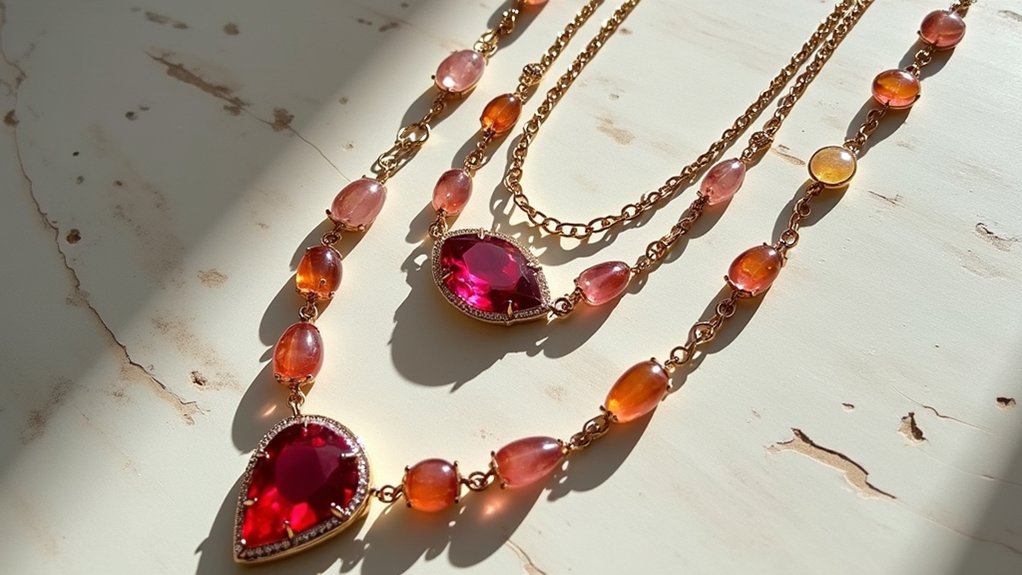
Since each jewelry layer competes for attention around your neckline, you’ll need to establish proper proportional spacing to prevent visual chaos and guarantee every piece shines on its own.
Follow essential layering tips by maintaining at least one-inch gaps between each layer to avoid tangling while creating proper spacing. Choose graduated lengths for your layered necklaces to achieve a stunning cascading effect that draws the eye naturally downward.
Vary chain widths and thicknesses to enhance visual appeal while maintaining distinct separation between pieces.
Consider your outfit’s neckline when planning layers—open necklines provide ideal space for multiple pieces, allowing better proportion and visibility.
Remember that thoughtful spacing transforms ordinary jewelry combinations into sophisticated, cohesive statements that elevate your entire look.
Consider Neckline Compatibility When Planning Your Design
Your outfit’s neckline acts as the foundation for successful statement jewelry layering, dictating which pieces will complement rather than compete with your clothing.
V-neck and scoop-neck tops create perfect canvases for showcasing multiple layered necklaces, allowing each statement piece to shine individually while contributing to the overall aesthetic. High-neck styles demand longer, bold necklace designs that won’t disappear into fabric. Off-the-shoulder or strapless outfits pair beautifully with shorter pieces that highlight your décolletage.
Master neckline compatibility by matching proportions carefully—oversized pieces can overwhelm delicate necklines.
Follow these layering tips: select varying lengths that create a graceful cascading effect, ensuring each layer remains visible and purposeful rather than cluttered or competing for attention.
Distribute Visual Weight to Avoid Overwhelming the Wearer
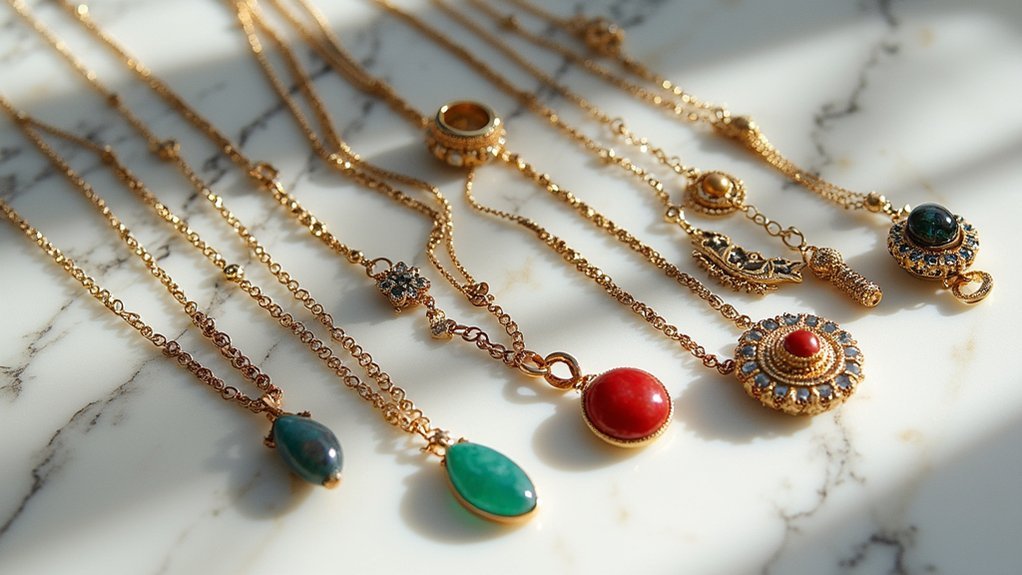
Successfully layered statement jewelry relies on carefully distributing visual weight across your entire ensemble to create balance rather than chaos.
Start with one dominant statement necklace as your anchor piece, then build around it with supporting layers that complement without competing. When layering necklaces, use graduated lengths to create a cascading effect that enhances visual flow.
Balance bold pieces with delicate settings to prevent overwhelming your look. Incorporate varying textures and materials – lighter pieces can effectively offset heavier items.
Consider your body frame when selecting proportions; larger frames support chunkier designs while petite individuals benefit from smaller, structured pieces.
This thoughtful approach to layering necklaces helps you create a harmonious look that’s sophisticated rather than cluttered.
Incorporate Texture Variation for Enhanced Dimension
You’ll create visual intrigue by pairing smooth metals with textured fabrics or hammered surfaces that catch light differently.
Balance your material choices by distributing heavier woven pieces alongside delicate chains to prevent any single element from dominating the composition.
Achieve surface finish harmony by mixing matte and polished elements strategically, allowing each texture to complement rather than compete with the others.
Smooth Meets Textured Contrast
When you combine smooth, polished metals with textured elements like hammered surfaces, rope chains, or intricate beadwork, you’ll create a striking visual dialogue that transforms ordinary layering into enchanting statement jewelry.
This contrasting approach prevents your layered pieces from blending together monotonously, allowing each element’s unique characteristics to shine.
Mix sleek chains with chunky, textured designs to establish dynamic focal points that guide the eye naturally through your aesthetic composition.
The interplay between matte and polished finishes elevates sophistication while ensuring your textures complement rather than compete.
Strategic placement of varied surfaces creates depth that makes even simple jewelry combinations appear intentionally curated and professionally styled.
Material Weight Distribution
Strategic material weight distribution forms the foundation of professional-looking layered jewelry, where heavier statement pieces anchor your base layer while lighter, delicate chains float gracefully above.
You’ll achieve ideal weight distribution by placing chunky necklaces closest to your neckline, then graduated lengths of progressively lighter pieces. This prevents tangling while guaranteeing each layer remains visible.
Contrasting weights create dynamic visual appeal—pair substantial pieces with delicate elements to highlight both.
When layering jewelry, balance visual weight through thoughtful material selection. Heavy metals provide stability, while intricate beading adds textural interest without overwhelming your ensemble.
Remember that graduated lengths prevent pieces from competing for space, allowing each element’s unique character to shine.
Strategic material weight distribution guarantees your layered looks maintain harmony rather than chaos.
Surface Finish Harmony
Surface finish harmony transforms ordinary layered jewelry into enthralling visual narratives through deliberate texture contrasts.
When you layer jewelry, mixing matte and shiny surface finishes creates essential depth that allows each piece to command attention while maintaining unity. You’ll achieve stunning results by pairing chunky necklaces with finely detailed pendants, balancing bold statement pieces against delicate textures.
Texture variation becomes your secret weapon for enhanced dimension. Hammered metals and woven designs add tactile appeal that invites closer examination.
You can create a cohesive look by strategically contrasting smooth surfaces with textured elements, ensuring your layering technique draws admiration without overwhelming your outfit. This thoughtful approach to surface finishes elevates your jewelry from simple accessories to sophisticated artistic expressions.
Frequently Asked Questions
How to Properly Layer Jewelry?
Start with one statement necklace as your focal point. Add shorter then longer pieces to create cascading lengths. Mix metals and textures while balancing bold with delicate pieces. Clean and store properly.
How to Wear Statement Jewellery?
You’ll want to choose one statement piece as your focal point and keep other accessories minimal. Balance bold jewelry with simpler clothing, ensuring your outfit’s neckline complements the piece’s size and style.
What Neckline to Wear With Statement Necklace?
Choose open necklines like V-necks, scoop necks, or off-the-shoulder styles to showcase your statement necklace best. You’ll create a clean canvas that lets the jewelry shine without competing with high collars or busy patterns.
What Is the Trick for Layering Necklaces?
You’ll want to vary necklace lengths for depth, start with a statement piece as your focal point, mix textures and materials, then add delicate layers while maintaining proper spacing between pieces.
In Summary
You’ll master statement jewelry layering by anchoring with one focal piece, then building thoughtfully around it. Don’t forget to vary your lengths and mix materials for visual intrigue. Pay attention to proportional spacing and how each layer complements your neckline. Balance is key—distribute weight evenly so you’re comfortable and confident. With these techniques, you’ll create stunning layered looks that showcase your personal style while maintaining sophisticated elegance.

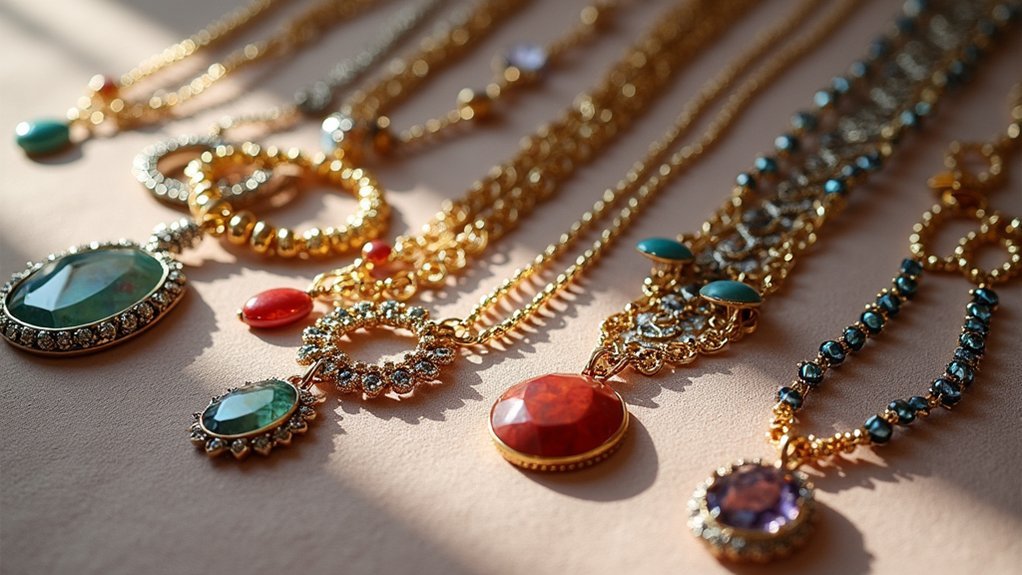



Leave a Reply